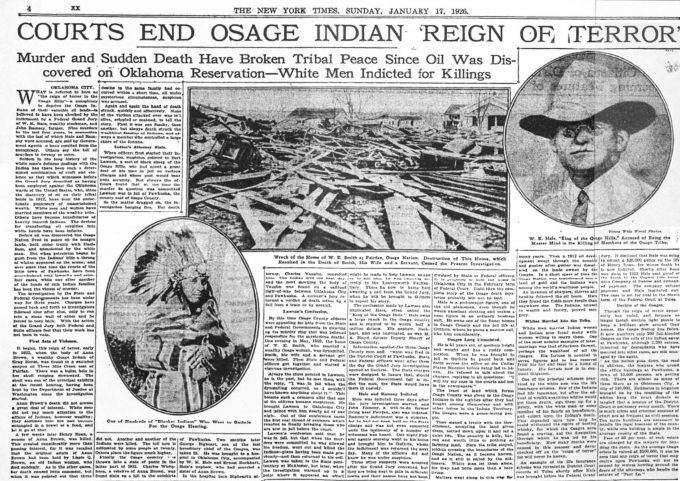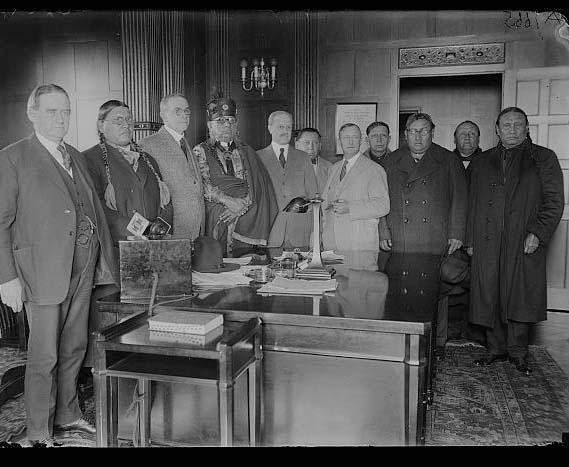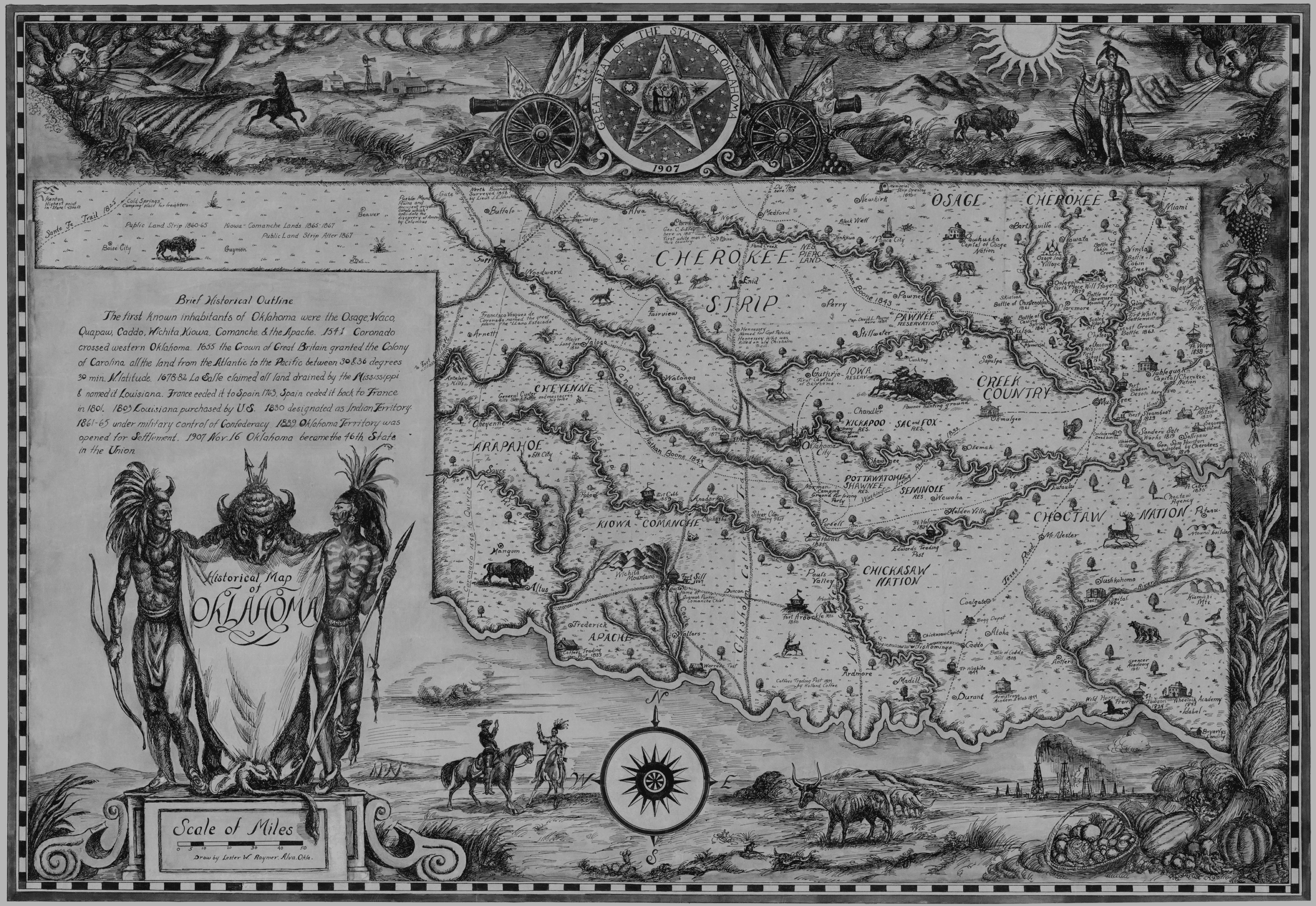1921-1926
Oil, Money, Murder.
Throughout history, settler rampage across the American West has largely been driven by one thing – money. Or in the case of Oklahoma, oil. In a series of particularly egregious cases, about two dozen violent and suspicious deaths among Osage Indians occurred in the 1920s, most of which were never investigated nor solved. Scholars and others who have investigated these cases more recently believe the actual number may be in the hundreds.
The Osage reservation was soaked in blood because it was awash in oil. Driven from their lands in Kansas, the Osage had acquired a swath of northeast Oklahoma in the early 1870s. The rocky, barren reservation promised to yield little until the discovery below the surface of one of the largest oil deposits in the United States. The Osage had retained the rights to any mineral discoveries, and oil barons paid large sums for leases at auction. Each member of the Tribe received large royalty payments.
The federal government stepped in to assign so-called ‘guardians,’ who were supposed to help the Osage manage their money. Instead, they transformed the arrangement into a widespread fraud scheme designed to steal the royalties. For some, this ill-gotten gain was not enough, and some hatched a cold-blooded plot to swindle the inheritance rights by marrying individual Indians before killing them. No such case was more chilling than that of William K. Hale, the self-proclaimed ‘King of the Osage Hills.’

Image: New York Times
The FBI’s first big case
An affluent rancher with banking and business interests, Hale was perhaps Osage County’s most powerful figure. He was also the mastermind of a plot to acquire Osage wealth through murder. Hale encouraged his nephew Ernest Burkhart to marry Mollie Kyle, a full-blood Osage. Her mother, Lizzie, resided with Mollie and Ernest. Lizzie died of a suspected poisoning in July 1921, two months after her daughter Anna Brown was shot to death. Henry Roan, Lizzie’s nephew, met a similar fate in January 1923. On March 10, 1923, Lizzie’s daughter Rita Smith, Rita’s husband William E. “Bill” Smith, and their housekeeper Nettie Brookshire died when their home was destroyed by an explosion. With Rita’s death, Mollie and Ernest Burkhart inherited a fortune from her mother and sister.
It wasn’t just Mollie’s family that was being methodically killed on the Osage Reservation in the early 1920s. More than two dozen members of the Tribe had been shot, stabbed, beaten and bombed in one of the bloodiest crime sprees in American history. Investigators who probed the case too deeply also turned up dead. One attorney with information on the case was thrown off a speeding train, while the body of Barney McBride, a wealthy white oilman who agreed to go to Washington, D.C., to ask federal authorities to investigate the murders, was found in a culvert, having been stripped, beaten and stabbed more than 20 times.
“The Osage Nation was soaked in blood because it was awash in oil.”
As the body count rose, the Osage saw no action from local and state law enforcement personnel. The Tribe appealed to the new Bureau of Investigation (later renamed the Federal Bureau of Investigation), for help. Newly appointed director J. Edgar Hoover sent investigators to Oklahoma. Their focus was on the Roan murder, which had occurred on restricted Indian land, giving federal authorities jurisdiction in the case. The officers met regularly to compare observations and noted the reoccurring names of William K. Hale, Ernest Burkhart, and John Ramsey. Under interrogation Ernest Burkhart tied Ramsey to the Roan murder, and Ramsey, a local farmer-cowboy, admitted that Hale had hired him to kill Roan. Ramsey also confessed his involvement in the Smith murders and implicated Hale as the ringleader in that crime, too. Federal agents, assisted by state officers, took Hale, Burkhart, and Ramsey into custody in January 1926 and soon charged others, as well.
Between 1926 and 1929 the defendants were tried in state and federal courts. The trials, with their deadlocked juries, appeals, and overturned verdicts, drew national attention. Ernest Burkhart pleaded guilty and received a life sentence in the Oklahoma State Penitentiary for the murder of William E. Smith. Turning state’s evidence, Burkhart testified against Hale and Ramsey, who were sentenced to life imprisonment in the Federal Penitentiary at Leavenworth, Kansas, for the murder of Henry Roan. A petty criminal, Kelsie Morrison admitted he had killed Anna Brown at Hale’s request.
In perhaps the cruelest irony of all, when the case was concluded Hoover’s Bureau sent the Osage a bill for $20,000 for its services! Despite Osage protests Hale, Ramsey, and Ernest Burkhart, were eventually paroled, and Burkhart received a full pardon in 1965 from Oklahoma governor Henry Bellmon.



